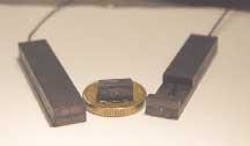Polymer is foundation for Nd:YAG laser
Aiming to simplify the construction of small Nd:YAG lasers, researchers at Acreo (Kista, Sweden) and the Royal Institute of Technology (Stockholm, Sweden) have developed a polymer-encapsulation technique in which a plastic carrier block with a V-groove serves to hold and align a small laser rod and the end of an optical fiber carrying light for pumping (see figure).1 A polymer lid completes the package.
The approach is an outgrowth of an earlier technique developed by the same group that is based on a silicon microbench carrier with wet-etched V-grooves.2 The silicon carrier enabled the fabrication of 6.7-W continuous-wave and 2-W Q-switched lasers built around 1-mm-diameter rods; the technology is now being commercialized by Cobolt (Stockholm, Sweden), says Sandra Johansson, one of the researchers.
In the polymer-carrier version, a thermally conductive polycarbonate with a V-groove 0.79 mm deep and 1.12 mm wide is formed using a standard injection-molding process. The polymer has a heat conductivity of 20 Wm-1K-1, which is a factor of 100 higher than for most polymers. After a piece of indium foil is placed in the V-groove, a 3-mm-long rhombic-cut Nd:YAG crystal is nestled in the groove. After another section of indium foil and a polymer lid are placed on top of the rod, the assembly is placed under slight pressure and heated to slightly under the melting point of indium to unify the assembly. The indium foil provides a good thermal contact, reduces stress caused by differences in thermal expansion of crystal and plastic, and cushions the crystal slightly in the groove.
A heat sink at 20°C cools the laser. The prototype device has a slope efficiency of 26%—somewhat lower than the silicon-carrier lasers, and attributed to mode-matching problems from a large pump volume. The laser's output reaches 2.08 W at 1064 nm and an M2 value of 8, and when run at 100 mW reaches an M2 of 2.5; thermal lensing is the predominant cause of the degradation in beam quality. A second prototype with a gradient-index lens to more accurately match the mode volume produced 100 mW at an M2 of 1.9. Cooling both the bottom and lid will further improve thermal management, says Johannson.
Polymer-encapsulated lasers can potentially be fabricated in large quantities at low cost, and can incorporate additional elements such as nonlinear crystals for production of other wavelengths. The researchers are targeting bioanalysis applications, but other possibilities include laser ranging, displays, micromachining, and graphics.
REFERENCES
- D. Evekull et al., Electron. Lett. 39(20) (Oct. 2, 2003).
- Å. Claesson et al., Adv. Solid State Lasers, ASSL 2000, WA2, Davos, Switzerland (Feb.13–16, 2000).
